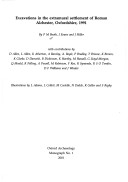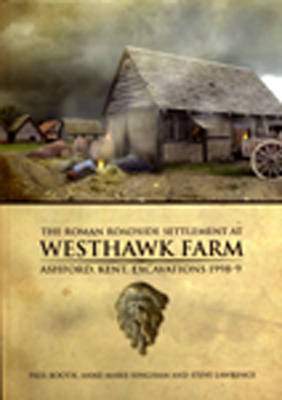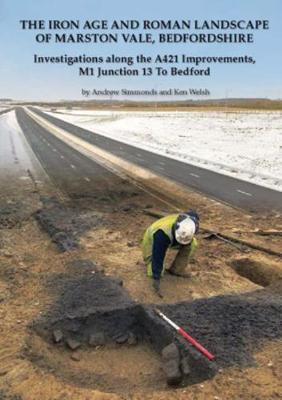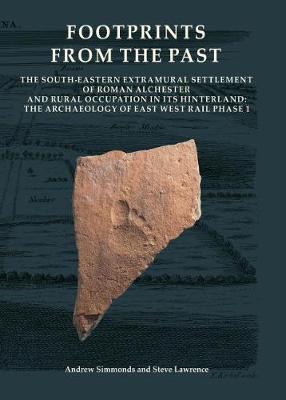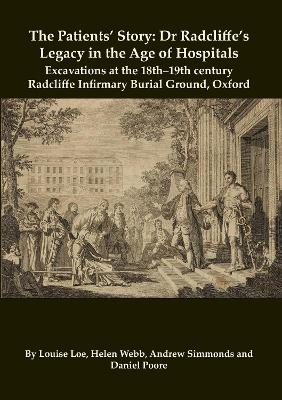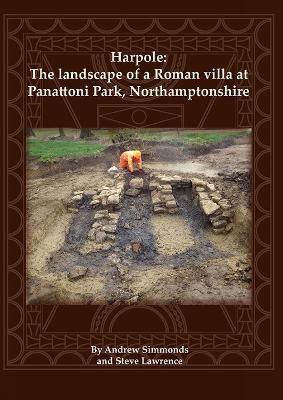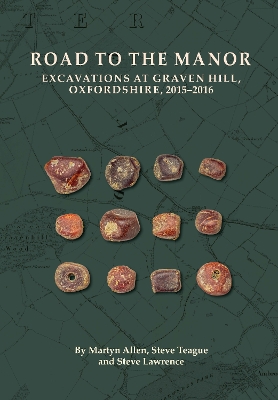Oxford Archaeology Monograph
7 primary works
Book 1
Excavations in the Extramural Settlement of Roman Alchester, Oxfordshire, 1991
by Paul Booth, Jeremy Evans, and Jonathan Hiller
Published 31 March 2002
This is a study of major excavations that took place in 1991 in the northern extramural settlement of the small Roman town of Alchester, Oxfordshire, in advance of road construction on the A421. These excavations produced Neolithic/Bronze Age flintwork, residual Beaker material and evidence for a middle Iron Age settlement, as well as extensive activity throughout the Roman period and post-Roman burials. This evidence has been integrated with that from other recent work in the Bicester area and the wider region at large to produce a new framework for understanding the development of the Roman town in its regional context. In the 1st to early 2nd centuries the Roman settlement was characterized principally by ditches on alignments relating to the early Roman Akeman Street. Later a system of ditched plots developed on each side of a minor lane parallel to and north of the line of Akeman Street. The settlement continued to the end of the Roman period and probably beyond, and there may have been some continuity in agricultural practices into the post-Roman period. A small late Roman cemetery with a post-Roman phase complemented the domestic structures and other features.
There were finds of a wide variety of types and materials, of which the most remarkable was a fragment of a monumental inscription. The pottery assemblage was also particularly large and significant. Smaller-scale work elsewhere on the road scheme uncovered a Bronze Age burial, a late Iron Age to early Roman settlement, and elements of the fields systems relating to the Roman town.
There were finds of a wide variety of types and materials, of which the most remarkable was a fragment of a monumental inscription. The pottery assemblage was also particularly large and significant. Smaller-scale work elsewhere on the road scheme uncovered a Bronze Age burial, a late Iron Age to early Roman settlement, and elements of the fields systems relating to the Roman town.
Book 2
The Roman Roadside Settlement at Westhawk Farm, Ashford, Kent
by Paul Booth, Anne-Marie Bingham, and Steve Lawrence
Published 29 October 2008
Westhawk Farm is the site of a large Roman settlement established at an important road junction shortly after the Roman conquest, discovered and partly excavated in advance of housing development. The settlement contained contrasting groups of carefully laid out plots and unplanned areas. Excavated timber buildings included circular and rectilinear structures and a polygonal shrine. The main concerns of the inhabitants were apparently agriculture and market services. Iron production was important, but probably only of local significance, although the settlement may have had a role in the administration the iron industry. Activity at the site had declined greatly by the mid 3rd century; a striking pattern reflected elsewhere in the region but still of uncertain significance.
Book 19
The Iron Age and Roman landscape of Marston Vale, Bedfordshire
by Andrew Simmonds and Ken Welsh
Published 1 April 2013
A programme of improvements to the A421 south-west of Bedford carried out by Balfour Beatty Civil Engineering Ltd on behalf of the Highways Agency afforded Oxford Archaeology an opportunity to investigate early settlement along a corridor of the clay landscape of Marston Vale, within the catchment of the River Great Ouse. The investigations comprised nine areas of excavation supplemented by watching briefs and earthwork surveys of three historic boundaries, as well as geophysical survey and field evaluation at a site that was not ultimately excavated. The Vale appears to have been visited only occasionally during the early prehistoric period, the evidence being limited to a sparse distribution of worked flint and a single cremation burial dated by radiocarbon to the early Iron Age. The majority of the remains uncovered dated from between the middle Iron Age and the late Roman period, and were consistently rural in character, consisting of a series of small farming settlements. The report describes the evolution of settlement within the Vale as evidenced by the changes to settlement forms, landscape organisation, economic strategies and material culture, brought about by the effects of an increasing population and the imposition of Roman rule. The level of activity declined during the late Roman period, and the remaining settlements were abandoned during the early part of the 4th century.
Book 28
Excavations by Oxford Archaeology in advance of a programme of improvements to the railway between Bicester and Oxford investigated part of the south-eastern extramural settlement associated with the Roman fortress and subsequent town at Alchester, Oxfordshire, as well as rural settlements in its rural hinterland.
The investigations at Alchester extended across two successive routes south to Dorchester-on-Thames, the earlier of which by-passed the eastern side of Otmoor and was superseded by a more direct route across the moor at the end of the 1st century AD. Settlement beside the earlier road may have been a successor to a pre-Roman settlement and appears from artefactual evidence to have been of quite high status during the initial, military phase, although no contemporary structural evidence was found. Stone-founded buildings were constructed during the late 1st-early 2nd century, including two single-celled structures of uncertain function that may represent a gatehouse or a pair of shrines. The buildings were demolished by c AD 200, when the area was abandoned. An insight into the diverse lives of the inhabitants is provided by finds that included part of a priestly headdress, two pairs of slave shackles and a group of roof tiles bearing the footprints of a young child. The extramural settlement may have been partly rural in character, involved in farming the landscape around the town, which was intensively managed for agricultural production, probably as meadow and pasture.
Ditched enclosures beside the later road may have been part of a second extramural area or a discrete farming establishment. No buildings were identified but two large pits contained domestic refuse and building material. Excavations at six other locations investigated farmsteads that dated from the middle Iron Age to the 3rd century AD and included a rare deposit of debris from copper and iron working from a middle Iron Age enclosure ditch.
The investigations at Alchester extended across two successive routes south to Dorchester-on-Thames, the earlier of which by-passed the eastern side of Otmoor and was superseded by a more direct route across the moor at the end of the 1st century AD. Settlement beside the earlier road may have been a successor to a pre-Roman settlement and appears from artefactual evidence to have been of quite high status during the initial, military phase, although no contemporary structural evidence was found. Stone-founded buildings were constructed during the late 1st-early 2nd century, including two single-celled structures of uncertain function that may represent a gatehouse or a pair of shrines. The buildings were demolished by c AD 200, when the area was abandoned. An insight into the diverse lives of the inhabitants is provided by finds that included part of a priestly headdress, two pairs of slave shackles and a group of roof tiles bearing the footprints of a young child. The extramural settlement may have been partly rural in character, involved in farming the landscape around the town, which was intensively managed for agricultural production, probably as meadow and pasture.
Ditched enclosures beside the later road may have been part of a second extramural area or a discrete farming establishment. No buildings were identified but two large pits contained domestic refuse and building material. Excavations at six other locations investigated farmsteads that dated from the middle Iron Age to the 3rd century AD and included a rare deposit of debris from copper and iron working from a middle Iron Age enclosure ditch.
Book 32
The Patients’ Story
by Louise Loe, Helen Webb, Andrew Simmonds, and Daniel Poore
Published 15 April 2022
Excavations at the site of the burial ground of the old Radcliffe Infirmary, Oxford, revealed the largest assemblage of individual burials yet recovered from an 18th/19th century hospital site in Britain. Founded in 1770 with funds from the estate of the Royal physician and MP John Radcliffe, the infirmary was rare in having its own dedicated burial ground. The skeletons span a short period of time, between 1770 and 1852, and comprise patients who had not been claimed for burial in their home parish. Virtually all of them are unidentified, but documentary evidence shows that they comprise members of the labouring and middle classes, most of whom had originated from the locality and the surrounding counties. Their bones provide an important perspective on the health of industrialising post-medieval populations, characterised by high rates of trauma and disease. They highlight the hitherto unrecognised role that the operating theatre and mortuary played in the development of medical education in Oxford. Further, they offer a unique and fascinating perspective on early modern hospital care, surgery and burial, from a period when hospitals underwent a radical transformation, becoming the medically-focused institutions that we know today.
Book 34
Excavations at Panattoni Park, at Harpole within the Nene Valley west of Northampton, uncovered part of a Roman villa and evidence for preceding prehistoric and early Roman settlement.
The earliest evidence was a Mesolithic flint-knapping site. During the early Iron Age or at the start of the middle Iron Age, a pit alignment was constructed running down the valley side. A middle Iron Age settlement of at least seven roundhouses lay 450m to the east of the pit alignment. It is likely that both the boundary and the settlement were associated with cattle grazing on the valley floor, and the settlement may have been seasonally occupied. An enclosure complex was constructed against the pit alignment during the late Iron Age and occupied until c AD 50/70, after which there was an apparent hiatus of about a century before the establishment of the villa during the mid-2nd century.
The villa was first discovered in the 1840s when a mosaic was accidentally uncovered. It was believed to have been largely destroyed during widening of the adjacent A4500 road in 1966 when excavation of only a small area was possible. However, the new excavation has demonstrated the survival of part of the main villa complex, including a substantial aisled building that may have formed the southern range. An extensive part of the agricultural landscape surrounding the villa was investigated, including an area devoted to malting and an enclosure complex used as a stockyard for processing livestock. A further notable find was a small hoard of mower’s tools, perhaps the toolkit of an individual agricultural worker.
A building interpreted as a temple-mausoleum of Romano-Celtic form situated beside a spring channel was also investigated. Pollen from the channel indicating the presence of a walnut grove may be the earliest definite evidence for the cultivation of walnut trees in Britain.
The earliest evidence was a Mesolithic flint-knapping site. During the early Iron Age or at the start of the middle Iron Age, a pit alignment was constructed running down the valley side. A middle Iron Age settlement of at least seven roundhouses lay 450m to the east of the pit alignment. It is likely that both the boundary and the settlement were associated with cattle grazing on the valley floor, and the settlement may have been seasonally occupied. An enclosure complex was constructed against the pit alignment during the late Iron Age and occupied until c AD 50/70, after which there was an apparent hiatus of about a century before the establishment of the villa during the mid-2nd century.
The villa was first discovered in the 1840s when a mosaic was accidentally uncovered. It was believed to have been largely destroyed during widening of the adjacent A4500 road in 1966 when excavation of only a small area was possible. However, the new excavation has demonstrated the survival of part of the main villa complex, including a substantial aisled building that may have formed the southern range. An extensive part of the agricultural landscape surrounding the villa was investigated, including an area devoted to malting and an enclosure complex used as a stockyard for processing livestock. A further notable find was a small hoard of mower’s tools, perhaps the toolkit of an individual agricultural worker.
A building interpreted as a temple-mausoleum of Romano-Celtic form situated beside a spring channel was also investigated. Pollen from the channel indicating the presence of a walnut grove may be the earliest definite evidence for the cultivation of walnut trees in Britain.
Book 35
Oxford Archaeology undertook a series of excavations in 2015–16 at Graven Hill on the former site of MoD Bicester, a large military storage and distribution centre built during the Second World War. The archaeological works revealed evidence of prehistoric, Roman, medieval and post-medieval activity, as well as finds relating to the use of the military site during the 1940s and 1950s.
Ephemeral signs of early prehistoric activity were limited to stone tools, including an impressive Neolithic axe head, and a Bronze Age cremation burial. The first sign of occupation dated to the middle Iron Age in the form of a small settlement on the northern slope of the hill. A late Iron Age settlement to the north-west appeared to have been abandoned shortly after the Roman invasion, perhaps as a direct consequence of the arrival of the army at Alchester, 1.6km west of Graven Hill. This coincided with the construction of Akeman Street, the alignment of which was discovered to circumnavigate the north side of the hill.
The town of Bicester later originated in the 6th century AD, around the time that a collection of dress and personal items were buried to the north of Graven Hill. A new farmstead was established in the late 11th century, developing in the 13th century with a series of masonry buildings arranged around a central courtyard, linked via a road to the deserted medieval village at Wretchwick. The site is significant for its well-preserved structural foundations and a considerable number of artefacts, including one of the largest medieval pottery assemblages known from rural Oxfordshire. The farmstead was abandoned about the same time as the village in the mid-14th century, perhaps as a result of the Black Death. The land was subsequently used for agriculture until the development of MoD Bicester in the 1940s. Together, the archaeological findings presented in this monograph have enriched our understanding of the history of the Oxfordshire landscape.
Ephemeral signs of early prehistoric activity were limited to stone tools, including an impressive Neolithic axe head, and a Bronze Age cremation burial. The first sign of occupation dated to the middle Iron Age in the form of a small settlement on the northern slope of the hill. A late Iron Age settlement to the north-west appeared to have been abandoned shortly after the Roman invasion, perhaps as a direct consequence of the arrival of the army at Alchester, 1.6km west of Graven Hill. This coincided with the construction of Akeman Street, the alignment of which was discovered to circumnavigate the north side of the hill.
The town of Bicester later originated in the 6th century AD, around the time that a collection of dress and personal items were buried to the north of Graven Hill. A new farmstead was established in the late 11th century, developing in the 13th century with a series of masonry buildings arranged around a central courtyard, linked via a road to the deserted medieval village at Wretchwick. The site is significant for its well-preserved structural foundations and a considerable number of artefacts, including one of the largest medieval pottery assemblages known from rural Oxfordshire. The farmstead was abandoned about the same time as the village in the mid-14th century, perhaps as a result of the Black Death. The land was subsequently used for agriculture until the development of MoD Bicester in the 1940s. Together, the archaeological findings presented in this monograph have enriched our understanding of the history of the Oxfordshire landscape.
